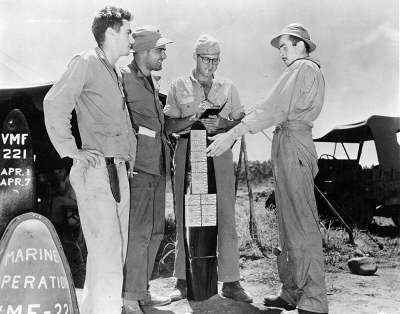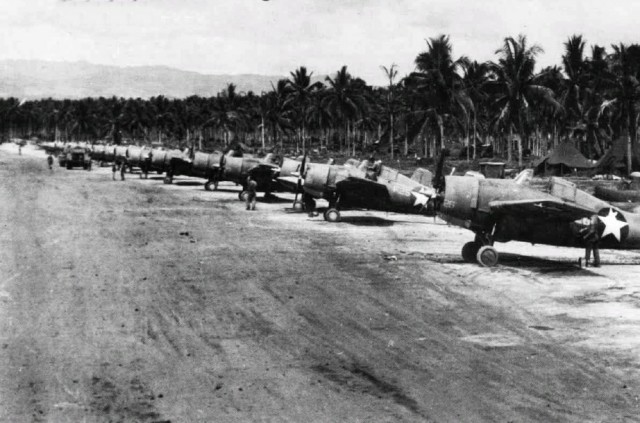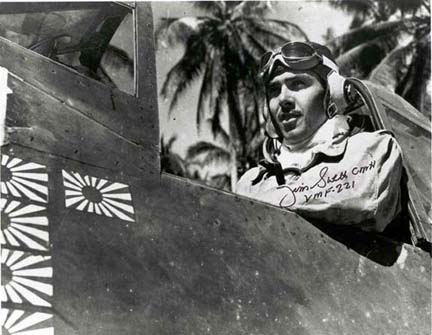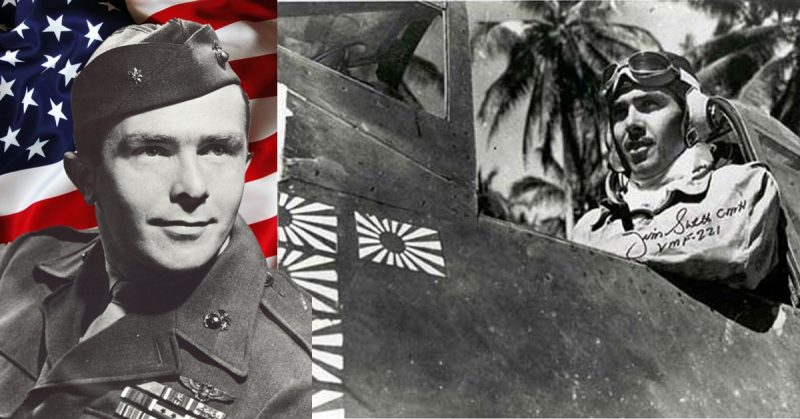Lieutenant James Swett wasn’t the only man to become an Ace in one day during the war and nor was he the only Ace to receive the Medal of Honor. However, he might very well be the only man to earn both the first time he ever flew a combat mission.
Taking to the skies near Guadalcanal, Swett would down seven enemy aircraft and was working on his 8th when he finally ran out of ammunition. Swett would go on to serve with distinction throughout the war having survived going down in a plane twice and once required rescue for indigenous tribes in a canoe.
By the time the war ended he was taking off from the decks of an aircraft carrier with over 15 confirmed kills, but it would be his first day of combat that would earn him a place among the fighter ace elite.
Born to Fly
James Swett was born in 1920 Seattle and eventually moved to San Mateo, California as a youth. In 1939, he enrolled in college and made a push to earn his private pilot’s license. He would eventually earn his private license which took considerably more flight hours to earn than what would be typical of fighter pilots in the war.
However, he was destined to take to the skies in a uniform and in August of 1941 he enlisted in the Navy Reserves and began flight training where he eventually graduated in 1942 in the top ten percent of his class.

He was then given a choice between a commission in the Navy or the Marine Corps; he subsequently chose the Marines. At this point, the Americans were fully immersed into the war in the Pacific and after lengthy training, Swett was assigned to VMF-221 at Guadalcanal. VMF-221 would be the second most victorious squadron in the Marine Corps racking up 185 enemy planes downed. And while Swett would play a major role in that overall score, his fame as a fighter pilot would all kick off for him on his very first day in combat.
First Day on the Job
After months of training and waiting, Swett’s moment for action had finally arrived. He took to the skies on April 7th, 1943 as the division leader for a combat air patrol over the Russell Islands. The Marines were anticipating a large approach of Japanese aircraft and their mission was to interdict and destroy as many as possible.
When a report of over 150 planes approaching Ironbottom Sound was issued, the Marines knew they had found their target. Taking his division of F4F Wildcats into the fray, Lieutenant Swett was ready for action. Coming into their sights was the massive formation of Japanese Aichi D3A (Val) dive bombers and the first shots of his war were fired.

Given the size of the formation, targets were plentiful, but navigation was very difficult and there was chaos in the sky. Swett zeroed in on three Vals that were descending for a raid on the harbor. Pursuing in his Wildcat, he quickly destroyed the first two before his plane was actually hit by American anti-aircraft fire that was targeting the approaching Japanese planes.
Despite damage to his left wing, Swett took out the third bomber and turned back into the battle for more. He found his next target in a line of bombers approaching for attack. With quick short bursts up close, he downed four more bombers bringing his total to 7 and making him an instant ace.
He was then tackling his 8th kill when his ammunition finally ran out. At this point, his cockpit had been shot to pieces by return fire and he was bleeding heavily. With his plane in tatters and no hope to make it back to the airfield, Swett successfully attempted a water landing apart from breaking his nose on the instrument panel due to the sudden stop.
As he attempted to exit the cockpit, his parachute straps become caught and dragged him beneath the sea with his plane. Descending to his demise for an undetermined period of time, his life raft suddenly inflated and jetted him to the surface just in time to catch his desperately needed next breath.
A Long War Ahead
A Coast Guard boat was able to pull him out of the water and took him to a nearby harbor where he was given morphine and a good deal of scotch to ease not only his pain, but what was likely the toughest first day at work he would ever experience. While recouping at a Naval Hospital, Swett was informed that he had been recommended for the Medal of Honor.
However, the war was still raging and this was no time to rest on his laurels. He joined back up with VMF-221 and was now flying the Vought F4U Corsair. Now a Captain, in June of 1943 Swett would add two Mitsubishi G4M “Betty” bombers to his total along with splitting the credit for a Mitsubishi A6M Zero.
Just a week later, he would add a couple of more Bettys and another Zero to his total near New Georgia Island. Unfortunately for Swett, it was the Zero he didn’t see that would send him once again careening into the sea. He was picked out of the sea by a couple of indigenous tribal members operating a 10-man canoe who paddled him several hours towards Allied forces and back into the fight.

After picking up a few additional kills, Swett returned to the United States where he would become carrier qualified and eventually assigned to the USS Bunker Hill. From the decks of the Bunker Hill, he would add his final kill which was a Yokosuka D4Y Judy kamikaze that Swett would describe as a sitting duck.
By war’s end, Swett had flown over 100 combat missions and was credited with 15.5 confirmed kills along with 4 more probable. He had earned two Purple Hearts, 8 Distinguished Flying Crosses, the Medal of Honor and a harrowing tale of avoiding drowning by riding to the surface of the sea on an inflating lift raft.
It was quite a long and distinguished resume for the man who had already accomplished more than most on his very first day at the “office.”
